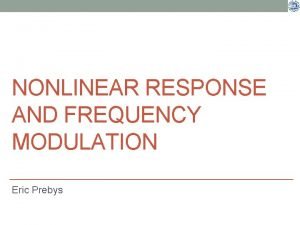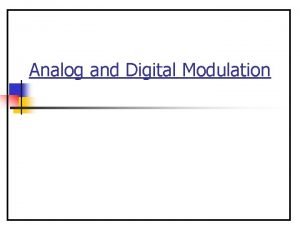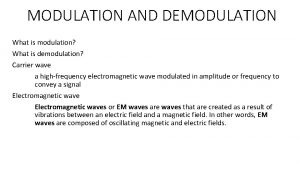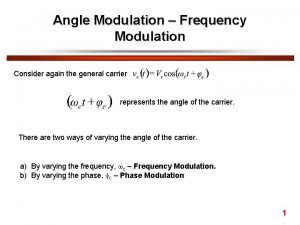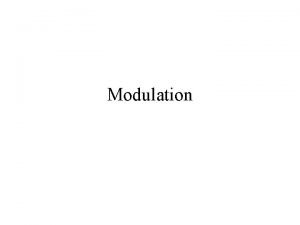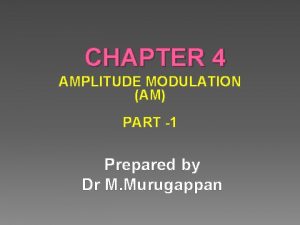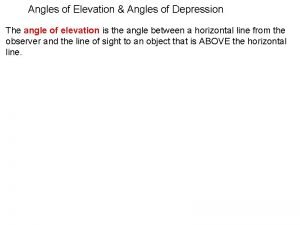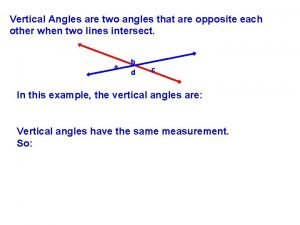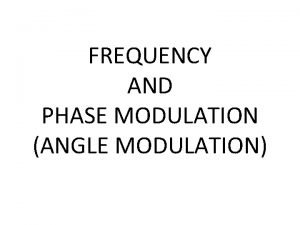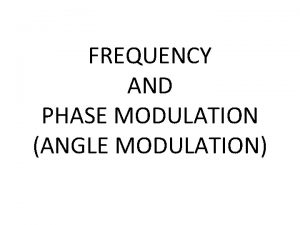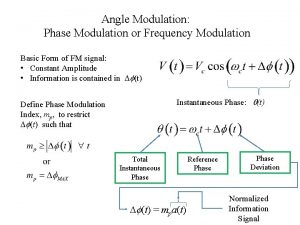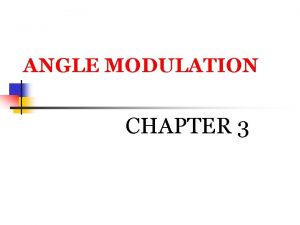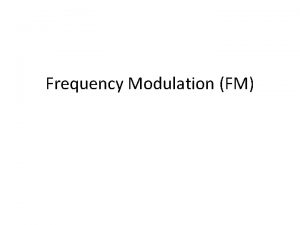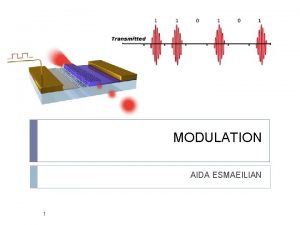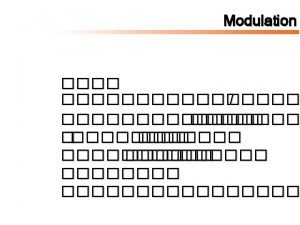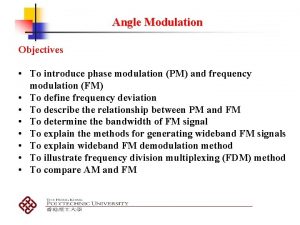ANGLE MODULATION AM Part 1 Principles of Frequency




































- Slides: 36

ANGLE MODULATION (AM) Part 1 Principles of Frequency Modulation (FM)

Objectives To define and explain frequency modulation (FM) and phase modulation (PM) To analyze the FM in terms of Mathematical analysis To analyze the Bessel function for FM and PM To analyze the FM bandwidth and FM power distribution

Lecture overview Frequency modulation (FM) and phase modulation (PM) Analysis of FM Bessel function for FM and PM FM bandwidth Power distribution of FM

Introduction Angle modulation is the process by which the angle (frequency or Phase) of the carrier signal is changed in accordance with the instantaneous amplitude of modulating or message signal. Advantage: noise reduction, improved system fidelity and more efficient use of power Disadvantage: required a wider bandwidth and more complex circuits in both transmitter and receiver.

Continue… Angle modulation is classified into two types such as › Frequency modulation (FM) › Phase modulation (PM) Used for : › › › Commercial radio broadcasting Television sound transmission Two way mobile radio Cellular radio Microwave and satellite communication system

Frequency Modulation (FM) Introduction FM is the process of varying the frequency of a carrier wave in proportion to a modulating signal. The amplitude of the carrier wave is kept constant while its frequency and a rate of change are varied by the modulating signal.

FM : Introduction (cont…) Fig 3. 1 : Frequency Modulated signal

FM : Introduction (cont…) The important waveforms are : i. The frequency varies. The rate of change of carrier frequency changes is the same as the frequency of the information signal. The amount of carrier frequency changes is proportional to the amplitude of the information signal. The amplitude is constant. ii. iv. features about FM

FM : Introduction (cont…) The FM modulator receives two signals, the information signal from an external source and the carrier signal from a built in oscillator. The modulator circuit combines the two signals producing a FM signal which passed on to the transmission medium. The demodulator receives the FM signal and separates it, passing the information signal on and eliminating the carrier signal.

FM : Introduction (cont…)

Analysis of FM Mathematical analysis: Let the message signal: And carrier signal: Where carrier frequency is very much higher than message frequency.

Analysis of FM � In FM, frequency changes with the change of the amplitude of the information signal. So the instantaneous frequency of the FM wave is; � � K is the deviation sensitivity.

Analysis of FM Thus, we get the FM wave as: Modulation index for FM is given by (Eq. 1) Where, K = deviation sensitivity (hertz per volt) Vm = peak modulating signal amplitude (volts) = cyclic frequency (hertz)

Analysis of FM Frequency deviation: ∆f is the relative placement of carrier frequency (Hz) with respect to its unmodulated value. For FM, the deviation sensitivity, K is often given in hertz per volt. Therefore, the peak frequency deviation is (Eq. 2)

Therefore, Eq. 2 can be substituted into Eq. 1, and the expression for the modulation index in FM can be rewritten as:

Example 1 FM broadcast station is allowed to have a frequency deviation of 75 k. Hz. If a 4 k. Hz (highest voice frequency) audio signal causes full deviation (i. e. at maximun amplitude of information signal) , calculate the modulation index.

Example 2 Determine the peak frequency deviation, ∆f and the modulation index, mf, for an FM modulator with a deviation sensitivity K = 5 k. Hz/V and a modulating signal Vm(t) = 2 cos (2π2000 t).

Equations for Phase- and Frequency. Modulated Carriers

FM & PM (Bessel function) The general equation for FM modulated wave:

Bessel function

Bessel Function It is seen that each pair of side band is preceded by J coefficients. The order of the coefficient is denoted by subscript m. The Bessel function can be written as n=number of the side frequency m=modulation index

Bessel Functions of the First Kind, Jn(m) for some value of modulation index • Jn are relative to the ampitude of the unmodulated carrier • Eg. : J 2 = 0. 35 means that the amplitude is equal to 35% of unmodulated carrier amplitude (0. 35 Vc)

Bessel Functions

Representation of frequency spectrum

Example 3 For an FM modulator with a modulation index m=1, a modulating signal Vm(t)=Vm sin(2π1000 t), and an unmodulated carrier Vc(t) = 10 sin(2π500 kt), determine : a)Number of sets of significant side frequencies b)Their amplitudes c)Draw the frequency spectrum showing their relative amplitudes.

FM Bandwidth Theoretically, the generation and transmission of FM requires infinite bandwidth. Practically, FM system have finite bandwidth and they perform well. The value of modulation index determine the number of sidebands that have the significant relative amplitudes If n is the number of sideband pairs, and line of frequency spectrum are spaced by fm, thus, the bandwidth is: It is called the actual bandwidth

Continue… Estimation of transmission bandwidth; Assume mf is large and n is approximate mf +2; thus Bfm=2(mf +2)fm = (1) is called Carson’s rule (approximate bandwidth)

Example 4 An FM modulator is operating with a peak frequency deviation ∆f = 20 k. Hz. The modulating signal frequency, fm is 10 k. Hz, and the 100 k. Hz carrier signal has an amplitude of 10 V. Determine : a)The minimum bandwidth using Bessel Function table (actual minimum bandwidth). b)The minimum bandwidth using Carson’s Rule (approximate minimum bandwidth). c)Sketch the frequency spectrum for (a), with actual amplitudes.

Deviation ratio (DR) The worse case modulation index which produces the widest output frequency spectrum. Where › ∆f(max) = max. peak frequency deviation › fm(max) = max. modulating signal frequency

Example 5 Determine the deviation ratio and bandwidth for the worst-case (widest-bandwidth) modulation index for an FM broadcast-band transmitter with a maximum frequency deviation of 75 k. Hz and a maximum modulating signal frequency of 15 k. Hz (b) Determine the deviation ratio and maximum bandwidth for an equal modulation index with only half the peak frequency deviation and modulating signal frequency. (a)

FM Power Distribution As seen in Bessel function table, it shows that as the sideband relative amplitude increases, the carrier amplitude, J 0 decreases. This is because, in FM, the total transmitted power is always constant and the total average power is equal to the unmodulated carrier power, that is the amplitude of the FM remains constant whether or not it is modulated.

Continue In effect, in FM, the total power that is originally in the carrier is redistributed between all components of the spectrum, in an amount determined by the modulation index, mf, and the corresponding Bessel functions. At certain value of modulation index, the carrier component goes to zero, where in this condition, the power is carried by the sidebands only.

Average Power The average power in unmodulated carrier The total instantaneous power in the angle modulated carrier. The total modulated power

Example 6 a) Determine the unmodulated carrier power for the FM modulator and condition given in Example 3, (assume a load resistance RL = 50 Ώ) b) Determine the total power in the angle modulated wave.

At the end of this chapter, you should be able, To define and explain frequency modulation (FM) and phase modulation (PM) To analyze the FM in terms of Mathematical analysis To analyze the Bessel function for FM and PM To analyze the FM bandwidth and FM power distribution

END OF CHAPTER 3 PART 1
 Amplitude modulation vs frequency modulation
Amplitude modulation vs frequency modulation Amplitude modulation vs frequency modulation
Amplitude modulation vs frequency modulation Advantages of angle modulation over amplitude modulation
Advantages of angle modulation over amplitude modulation Modulation demodulation
Modulation demodulation Frequency shift keying modulation
Frequency shift keying modulation Frequency modulation
Frequency modulation Bypervolt
Bypervolt Fm vs am
Fm vs am Types of frequency modulation
Types of frequency modulation Formula for modulation index
Formula for modulation index Trapezoidal pattern am modulation
Trapezoidal pattern am modulation How to find conditional relative frequencies
How to find conditional relative frequencies Frequency vs relative frequency
Frequency vs relative frequency Average of sine wave
Average of sine wave Vmax=aw
Vmax=aw Frequency vs relative frequency
Frequency vs relative frequency Marginal frequency table
Marginal frequency table Marginal relative frequency
Marginal relative frequency Similarity statement
Similarity statement At what angle of incidence is the angle of refraction 90
At what angle of incidence is the angle of refraction 90 Third angle system
Third angle system What is an angle whose vertex is the center of the circle
What is an angle whose vertex is the center of the circle Rotary cutting instruments in operative dentistry
Rotary cutting instruments in operative dentistry Absolute angle vs relative angle
Absolute angle vs relative angle Adjacent angles linear pair
Adjacent angles linear pair Name an angle adjacent to fgi
Name an angle adjacent to fgi Angle klm and angle mln are linear pair
Angle klm and angle mln are linear pair Bisectors worksheet
Bisectors worksheet Angle addition practice answer key
Angle addition practice answer key Types of extinction in geology
Types of extinction in geology Angle 1 and angle 2 are supplementary
Angle 1 and angle 2 are supplementary Drilling definition
Drilling definition Angle of elevation and angle of depression word problems
Angle of elevation and angle of depression word problems Vertically opposite angles
Vertically opposite angles Reflexive property
Reflexive property Lesson 4 measuring angles
Lesson 4 measuring angles First angle projection and third angle projection
First angle projection and third angle projection
